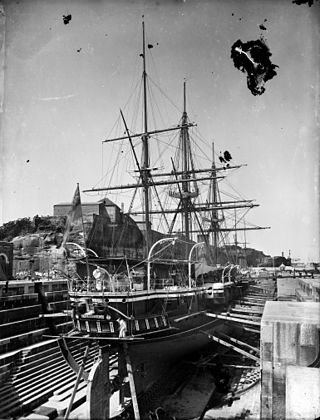HMS Curacoa (1878)
Comus-class corvette of the British Royal Navy From Wikipedia, the free encyclopedia
HMS Curacoa was a Comus-class corvette of the Royal Navy, built by John Elder & Co., Govan, launched in 1878, and sold in 1904 to be broken up.[2] She served on the Cape of Good Hope and West Africa Station, the Australia Station and as a training cruiser in the Atlantic.
 HMS Curacoa drydocked in Sydney Harbour c.1890. | |
| History | |
|---|---|
| Name | Curacoa |
| Builder | John Elder & Co., Govan |
| Yard number | 210 |
| Launched | 18 April 1878 |
| Fate | Sold 1904 for breaking up. |
| General characteristics | |
| Class and type | Comus-class corvette |
| Displacement | 2,380 LT (2,420 t; 2,670 ST) |
| Length | 225 ft (69 m) |
| Beam | 44 ft (13 m) |
| Draught | 19 ft (6 m) |
| Propulsion | Single screw driven by compound engines of 2,590 ihp (1.93 MW) |
| Sail plan | Barque or ship rig |
| Speed | 13.75 kt (25.5 km/h) powered; 14.75 kt (27.3 km/h) |
| Armament |
|
| Armour | Deck: 1.5 in (38 mm) over engines |
Service history
HMS Curacoa was built by John Elder & Co., Govan, and launched on 18 April 1878.
The corvette commenced service on the Cape of Good Hope and West Africa Station before being transferred to the Australia Station arriving on 5 August 1890. She left the Australia Station in December 1894.[2]
Curacoa was sent to the Ellice Islands and between 9 and 16 October 1892 Captain Herbert Gibson visited each of the islands to make a formal declaration that the islands were to be a British Protectorate.[3] In June 1893 Captain Gibson visited the southern Solomon Islands and made the formal declaration of the British Solomon Islands Protectorate.[4]
Her later years were spent as a training cruiser. In February–March 1900 she visited Madeira, Las Palmas and São Vicente, Cape Verde.[5][6]
She was sold in May 1904 to King of Garston for breaking up.[2]

References
External links
Wikiwand - on
Seamless Wikipedia browsing. On steroids.
